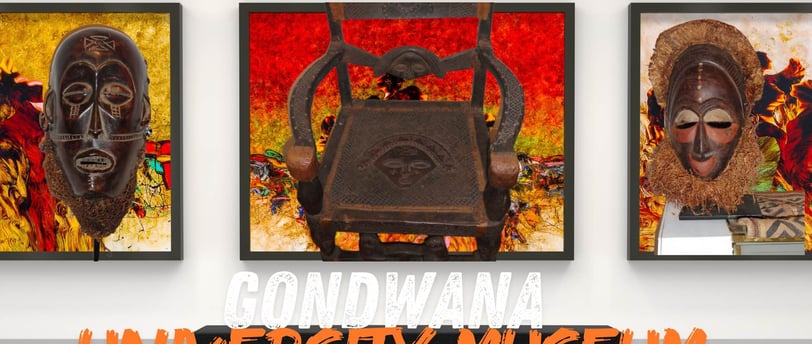"Gondeco: Engineering innovative solutions for underserved communities worldwide."
Preserving Heritage: The Cultural Significance of Gondwana University Museum (GUM)
Written by: Saji MUANZA
9/10/20244 min read


Introduction to Gondwana University Museum (GUM)
The Gondwana University Museum (GUM) stands as a beacon of cultural preservation and education. Nestled in the serene landscapes of Gondwana, it was established with the mission to conserve endangered cultural artifacts and to provide a platform for educating the public on the rich heritage of the region. Since its inception, GUM has committed itself to the vital task of safeguarding the tangible and intangible heritage of the Gondwana community and beyond.
Founded in 2001, the museum was born from a collective effort of local historians, academicians, and cultural enthusiasts who recognized the urgent need to preserve regional artifacts and narratives. Strategically located within the university grounds, GUM offers a unique blend of academic rigor and cultural sensitivity. Its geographical positioning not only makes it accessible to students and scholars but also to tourists and local communities, fostering a broader appreciation and understanding of cultural heritage.
The mission of GUM extends beyond mere preservation. It ambitiously aims to educate and inspire future generations about the multifaceted cultural legacies of Gondwana. The museum's extensive collections include indigenous art, ancient manuscripts, traditional attire, and historical relics that echo the socio-cultural evolution of the region. Moreover, GUM plays an instrumental role in organizing cultural events, workshops, and seminars that promote active engagement with heritage conservation efforts.
In the grand narrative of heritage preservation, GUM holds a significant place both regionally and nationally. It serves as a critical conduit through which the rich tapestry of Gondwana's past is woven into the broader story of the nation. By spotlighting regional histories and traditions, GUM not only preserves the past but also invigorates contemporary cultural identities and fosters a collective sense of pride and continuity. Through its dedicated efforts, the museum ensures that the cultural riches of Gondwana are celebrated and safeguarded for future generations.
```
Gondwana University Museum (GUM) serves as a custodian of invaluable cultural heritage, focusing particularly on endangered artifacts, artworks, and traditions. Among its most esteemed collections are intricately designed tribal masks, ancient manuscripts, and traditional clothing, each narrating a unique historical tale. These items are not only significant for their artistic value but also for their role in preserving the intangible cultural identity of various communities.
One of the museum’s crowning jewels is its array of tribal masks. These artifacts, carved from wood and painted with natural dyes, reflect the spiritual and social beliefs of Gondwana’s indigenous tribes. The deterioration of these masks due to exposure to environmental factors represents a critical loss to cultural heritage. Hence, GUM employs cutting-edge preservation techniques such as controlled climate environments and organic compound treatments to ensure these irreplaceable items are protected for future generations.
Equally significant are the ancient manuscripts housed within GUM. Written in various scripts and languages, these texts offer profound insights into the philosophical, literary, and historical contexts of bygone eras. To combat the effects of aging, the museum engages in meticulous digitization and restoration projects. These efforts not only preserve the physical integrity of the manuscripts but also make them accessible to scholars and researchers worldwide.
The traditional clothing collection at GUM showcases the intricate handicrafts of Gondwana’s tribes, embodying the region's rich textile heritage. These garments, often made from natural fibers and adorned with unique embroidery, are susceptible to wear and degradation. Preventive conservation methods are employed, incorporating both traditional techniques and modern science, to ensure their longevity.
The selection and preservation of these artifacts are governed by stringent criteria, meticulously evaluated by the museum’s curators and researchers. Each item undergoes a comprehensive assessment process, examining its historical significance, current condition, and cultural value. This scientific and cultural approach not only safeguards tangible objects but also plays a pivotal role in protecting endangered traditions and practices associated with them.
Through these dedicated efforts, GUM aspires to foster a deeper understanding and appreciation of Gondwana’s rich cultural tapestry, ensuring that these treasures are not lost to the ravages of time.
Educational and Cultural Enrichment Initiatives
Gondwana University Museum (GUM) has established itself as a pivotal institution in the realm of educational and cultural enrichment. Through a series of meticulously curated programs and initiatives, GUM aims to foster a deeper understanding and appreciation of the region's rich historical and cultural heritage. These efforts are not only directed at academics and researchers but also at the larger community, emphasizing inclusivity and lifelong learning.
A cornerstone of GUM's educational mission is its collaboration with schools and universities. Tailored educational programs provide students with hands-on learning experiences that bring the past to life. These programs include guided tours, interactive workshops, and curated lectures, all designed to integrate seamlessly with various academic curricula. By doing so, GUM ensures that students gain a comprehensive understanding of the historical and cultural narratives that have shaped their region.
In addition to educational programs, GUM is committed to making cultural preservation an engaging and accessible endeavor for the community. The museum regularly hosts cultural events that showcase traditional arts, crafts, and performances. Special exhibits often focus on significant historical periods or cultural practices, drawing both local and international attention. These exhibits work hand-in-hand with workshops where participants can learn traditional art forms, such as pottery, weaving, and folk dance, from skilled artisans. Such interactive engagements not only bolster cultural pride but also prevent these art forms from fading into obscurity.
Community outreach is another critical component of GUM’s initiatives. The museum works closely with local communities to document and preserve oral histories and folk traditions. Collaboration with local storytellers, historians, and cultural practitioners ensures that the museum's collection remains dynamic and representative of diverse cultural expressions. Public lectures and symposiums provide platforms for the community to engage in dialogue about cultural preservation and its importance to collective identity.
Through these multifaceted initiatives, GUM substantially contributes to cultural enrichment and lifelong learning. By maintaining a close-knit relationship with educational institutions and the community, GUM fosters an environment where history and culture are not just preserved, but are also actively celebrated and perpetuated. This ongoing commitment enhances the public's understanding and appreciation of the unique cultural tapestry that Gondwana University Museum so diligently safeguards.
Empower dilapidated communities through specialized services worldwide.
CONTACT
contact@gondeco.com
+1 (510) 387-2755
© 2024. All rights reserved.
124 Brenner Street, Hercules,California, 94547,
United States of America


